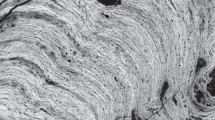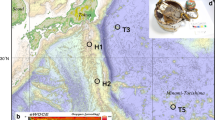Abstract
The oldest sediment most recently recovered from the Arctic Ocean is a biosiliceous ooze nearly devoid of nonbiogenic particles and exhibiting small-scale color changes. Color variations are due to changes in iron and manganese content. These elements are probably of local hydrothermal origin, and the Mn precipitation may be bacteria-mediated. An iron silicate phase seems to form at the expense of biogenic silica. The ooze deposited slowly until a sudden sediment input, probably a volcanigenic deposit now weathered to clay minerals, induced dissolution of siliceous microfossils. This clay layer contains calcium phosphate microspheres enriched in rare earth elements.
Similar content being viewed by others
References
Mudie PJ, Blasco SM (1985) Lithostratigraphy of the CESAR cores. In: Jackson HR, Mudie PJ, Blasco SM (eds) Initial Geological Report on CESAR—the Canadian Expedition to Study the Alpha Ridge, Arctic Ocean. Geological Survey Canada Paper 84-22, pp 59–99
Mudie PJ (1985) Palynology of the CESAR cores, Alpha Ridge. In: Jackson HR, Mudie PJ, Blasco SM (eds) Initial Geological Report on CESAR—the Canadian Expedition to Study the Alpha Ridge, Arctic Ocean. Geological Survey Canada Paper 84-22, pp 149–174
Bukry D (1985) Correlation of late Cretaceous Arctic silicoflagellates from the Alpha Ridge. In: Jackson HR, Mudie PJ, Blasco SM (eds) Initial Geological Report on CESAR—the Canadian Expedition to Study the Alpha Ridge, Arctic Ocean. Geological Survey Canada Paper 84-22, pp 125–135
Mudie PJ, Stoffyn-Egli P, Van Wagoner NA (1987) Geological constraints for tectonic models of the Alpha Ridge. Journal Geodynamics 6:215–236
Ling HY, McPherson LM, Clark DL (1973) Late Cretaceous (Maestrichtian?) silicoflagellates from the Alpha Cordillera of the Arctic Ocean. Science 180:1360–1361
Clark DL (1974) Late Mesozoic and early Cenzoic sediment cores from the Arctic Ocean. Geology 2:41–44
Clark DL, Byers CW, Pratt LM (1986) Cretaceous black mud from the central Arctic Ocean. Paleoceanography 1:265–271
Iijima A, Utada M (1983) Recent developments in the sedimentology of siliceous deposits in Japan. In: Iijima A, Hein JR, Siever R (eds) Siliceous Deposits in the Pacific Region. Elsevier Science Publishing, New York, pp 45–64
Hein JR, Kuijpers EP, Denyer P, Sliney RG (1983) Petrology and geochemistry of Cretaceous and Paleogene cherts from western Costa Rica. In: Iijima A, Hein JR, Siever R (eds) Siliceous Deposits in the Pacific Region. Elsevier Science Publishing, New York, pp 143–174
Yoshida S (1983) Chert-laminite, one of the principal sediments in a geosyncline. In: Iijima A, Hein JR, Siever R (eds) Siliceous Deposits in the Pacific Region. Elsevier Science Publishing, New York, pp 441–456
Welton JE (1984) SEM Petrology Atlas. American Association Petroleum Geologists Methods in Exploration Series 4, Tulsa, Oklahoma, 237 pp
Kitchell JA, Clark DL (1982) Late Cretaceous-Paleogene paleogeography and paleocirculation: evidence of north polar upwelling. Paleogeography, Paleoclimatology, Paleoecology 40:135–165
Smith FGW, Kalber FA (1974) Handbook of Marine Science 2. CRC Press, Cleveland, Ohio, 377 pp
Bonatti E (1981) Metal deposits in the oceanic lithosphere. In: Emiliani C (ed) The Sea 7. John Wiley & Sons, New York, pp 639–686
Martin JH, Knauer GA (1973) The elemental composition of plankton. Geochimica Cosmochimica Acta 37:1639–1653
Collier R, Edmond J (1984) The trace element geochemistry of marine biogenic particulate matter. Progress in Oceanography 13:113–199
Wollast R (1974) The silica problem. In: Goldberg ED (ed) The Sea 5, John Wiley & Sons, New York, pp 359–392
Forsyth DA, Asudeh I, Green AG, Jackson HR (1986) Crustal structure of the northern Alpha Ridge beneath the Arctic Ocean. Nature 322:349–352
Van Wagoner NA, Robinson PT (1985) Petrology and geochemistry of a CESAR bedrock sample: implications for the origin of the Alpha Ridge. In: Jackson HR, Mudie PJ, Blasco SM (eds) Initial Geological Report on CESAR—The Canadian Expedition to Study the Alpha Ridge. Geological Survey Canada Paper 84-22, pp 47–57
Marshall KC (1979) Biogeochemistry of manganese minerals. In: Trudinger PA, Swaine DJ (eds) Biogeochemical Cycling of Mineral-Forming Elements. Elsevier Science Publishing, New York, pp 253–292
Nealson KH (1983) The microbial iron cycle. In: Krumbein WE (ed) Microbial Geochemistry. Blackwell Scientific Publications, Boston, pp 191–221
Cowen JP, Silver MW (1984) The association of iron and manganese with bacteria on marine macroparticulate material. Science 224:1340–1342
Cowen JP, Bruland KW (1985) Metal deposits associated with bacteria: implications for Fe and Mn marine biogeochemistry. Deep-Sea Research 32:253–272
Cowen JP, Massoth GJ, Baker ET (1986) Bacterial scavenging of Mn and Fe in a mid- to far-field hydrothermal particle plume. Nature 322:169–171
Emerson S, Kalhorn S, Jacobs L, Tebo BM, Nealson H, Rosson RA (1982) Environmental oxidation rate of manganese (11): bacterial catalysis. Geochimica Cosmochimica Acta 46:1073–1079
Tebo BM (1983) The Ecology and Ultrastructure of Marine Manganese Oxidizing Bacteria. Ph.D. Thesis, University Microfilms International, Ann Arbor, Michigan, 220 pp
Ghiorse WC (1980) Electron microscopic analyses of metaldepositing microorganisms in surface layers of Baltic Sea ferromanganese concretions. In: Trudinger PA, Walter MR, Ralph BJ (eds) Biogeochemistry of Ancient and Modern Environments. Springer-Verlag, New York, pp 345–354
Muir MD (1978) Microenvironments of some modern and fossil iron- and manganese-oxidizing bacteria. In: Krumbein WE (ed) Environmental Biogeochemistry and Geomicrobiology 3. Ann Arbor Science, Ann Arbor, Michigan, pp 937–944
Knoll AH, Awramik SM (1983) Ancient microbial ecosystems. In: Krumbein WE (ed) Microbial Geochemistry. Blackwell Scientific Publications, Boston, pp 287–315
Hein JR, Yeh H-W, Alexander E (1979) Origin of iron-rich montmorillonite from the manganese nodule belt of the North Equatorial Pacific. Clays and Clay Minerals 27:185–194
Marchig V, Gundlach H (1981) Separation of iron from manganese and growth of manganese nodules as a consequence of diagenetic ageing of radiolarians. Marine Geology 40:M35-M43
Cole TG (1985) Composition, oxygen isotope geochemistry, and origin of smectite in the metalliferous sediments of the Bauer Deep, southast Pacific. Geochimica Cosmochimica Acta 49:221–235
Winters GV, Buckley DE (1986) The influence of dissolved FeSi3O3 (OH)8 0 on chemical equilibria in pore waters from deep-sea sediments. Geochimica Cosmochimica Acta 50:277–288
De Lange GJ, Rispens FB (1986) Indication of a diagenetically induced precipitate of an Fe-Si mineral in sediment from the Nares abyssal plain, western North Atlantic. Marine Geology 73:85–97
Hein JR, Scholl DW (1978) Diagenesis and distribution of late Cenozoic volcanic sediment in the southern Bering Sea. Geological Society America Bulletin 89:197–210
Kastner M, Siever R (1979) Low temperature feldspars in sedimentary rocks. American Journal Science 279:435–479
Lowenstam HA (1981) Minerals formed by organisms. Science 211:1126–1131
O'Brien GW, Harris JR, Milnes AR, Veeh HH (1981) Bacterial origin of East Australian continental margin phosphorite. Nature 294:442–444
Gibbs PG, Bryan GW (1984) Calcium phosphate granules in muscle cells of Nephtys (Annelida, Polychaeta)—a novel skeleton? Nature 310:494–495
Afschuler ZS (1980) The geochemistry of trace elements in marine phosphorites. Part 1. Characteristic abundances and enrichment. In: Bentor YK (ed) Marine Phosphorites-Geochemistry, Occurrence, Genesis. Society Economic Paleontologists and Mineralogists Special Publication 29, pp 19–30
Holland HD (1984) The Chemical Evolution of the Atmosphere and Oceans. Princeton University Press, Princeton, pp 498–506
Clark AM (1984) Mineralogy of the rare earth elements. In: Henderson P (ed) Rare Earth Element Geochemistry. Elsevier, Amsterdam, pp 33–61
Author information
Authors and Affiliations
Rights and permissions
About this article
Cite this article
Stoffyn-Egli, P. Iron and manganese micro-precipitates within a cretaceous biosiliceous ooze from the Arctic Ocean: possible hydrothermal source. Geo-Marine Letters 7, 223–231 (1987). https://doi.org/10.1007/BF02242775
Received:
Revised:
Issue Date:
DOI: https://doi.org/10.1007/BF02242775




